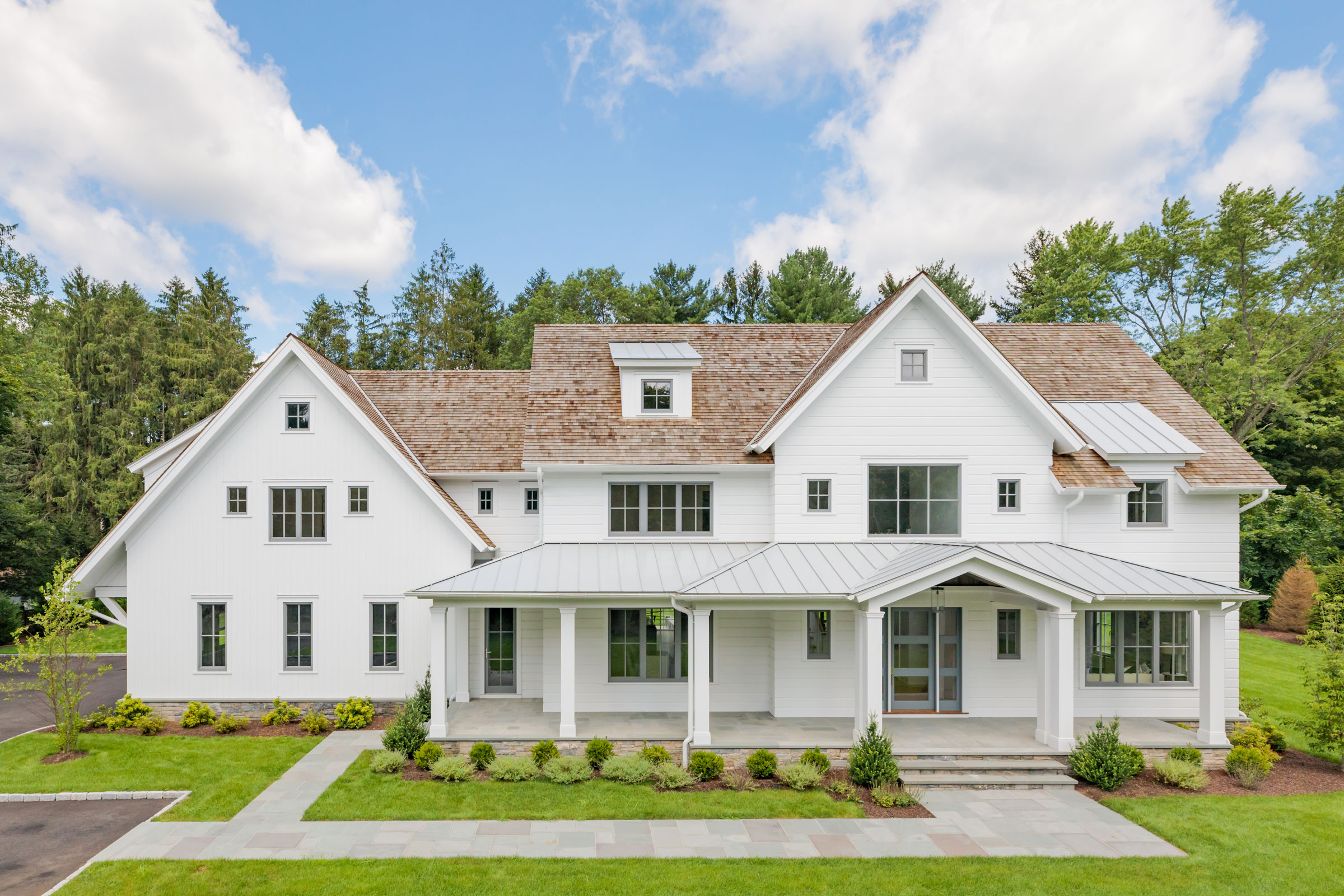Story at a glance:
- Siding is a home’s first line of defense against the elements and plays a large role in maintaining a healthy, comfortable indoor environment.
- Hardwood and vinyl are two of the most common siding materials, but they are far from the only options.
- Modern siding comes in many styles, colors, and textures so you can easily achieve your desired architectural style.
Modern house siding ideas not only protect your home from the elements, but they can also add to the aesthetics of a modern house.
Without proper siding, water can cause major damage like mold or foundational issues. Siding is often necessary, but that doesn’t mean it can’t also be beautiful.
Here are a few modern house siding ideas that will protect and enhance your next residential project.
What is Siding?
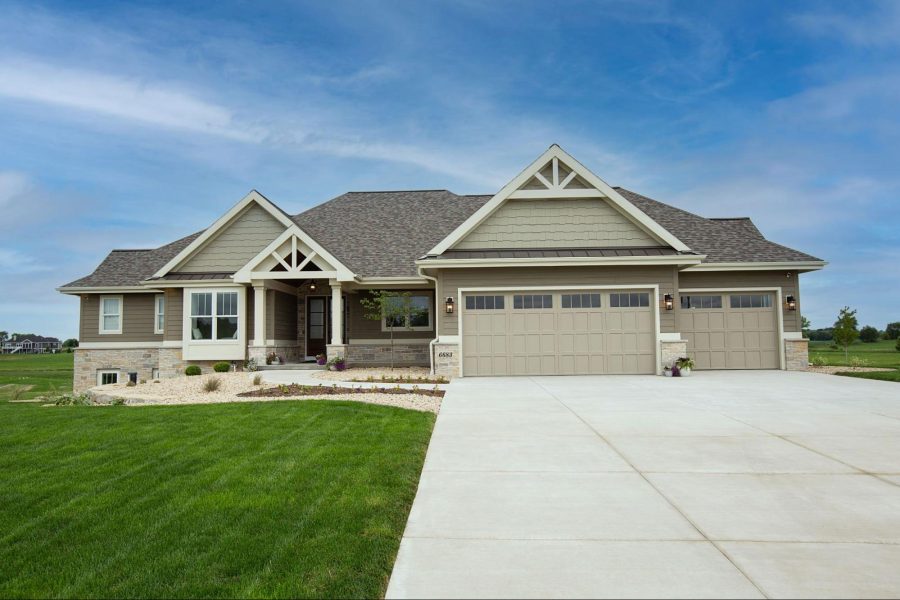
Photo courtesy of LP Building Solutions
Siding is a protective material affixed to the exterior-facing walls of a home or other building. Along with the roof, siding is a home’s first line of defense against the elements—primarily wind and rain—protecting both the interior and structural system from costly weather damage. All internally framed walls require siding as an integral component of their design, whereas structural wall systems, like brick masonry walls, do not require siding, but can still benefit from the addition of it.
Siding may be constructed from a variety of materials and installed in a range of styles, with the most common being board and batten, clapboard, shake, scalloped, and various arrangements of overlapping boards.
15 Modern House Siding Ideas
Here are 15 modern housing siding ideas to consider for your next residential project.
1. Engineered Wood

Engineered wood siding looks, acts, and cuts like conventional wood siding, but it has better moisture resistance and a higher durability. Photo courtesy of LP Building Solutions
Natural hardwoods have long dominated the siding market thanks to their aesthetic qualities—but as we’ve seen, they also come with a host of potential problems. That’s why companies like LP Building Solutions have expanded their options to include engineered wood, a siding solution designed to replicate the appearance of traditional wood siding without suffering the same disadvantages.
Engineered wood siding is a type of composite siding created by shredding wood into fibrous strands and then binding them together with resinous compounds. The resulting mixture is then exposed to extreme heat and pressed to form durable panels, after which point a wax coating is applied to the wood in order to improve its overall moisture resistance. It is also common for engineered wood to be impregnated with zinc borate to help deter insects and fungal decay.
LP Building Solutions offers engineered wood siding in the form of LP SmartSide, a carbon-negative engineered wood siding that looks, acts, and cuts like wood while boasting a higher degree of all around resilience. “We offer a good level of durability due to the waxes and resins in the product but also the orientation of the strand to make them more durable,” Isaac Ojeda, construction service associate at LP Building Solutions, told gb&d in a previous article. “During manufacturing the strands are arranged in cross-directional layers to help improve the resilience of the product.”
LP SmartSide is designed to withstand hail up to 1.75 inches in diameter and is backed by a limited 50-year warranty. LP Building Solutions also offers LP SmartSide Expert Finish, a prefinished siding option available in 16 colors and backed by a 15-year paint warranty; both the standard and Expert Finish SmartSide siding is available in smooth and cedar grain textures, making it extremely versatile.
And like other wood-based siding products, engineered wood has the advantage of being a largely sustainable siding material option, especially if the wood used in its manufacturing is sourced from FSC-certified forests or reclaimed from other projects.
Pros of Engineered Wood Siding
- Extremely durable
- Cost effective
- Easy to install
Cons of Engineered Wood Siding
- Potential for moisture damage
- May fade over time
- Lacks natural variation
2. Stucco

Stucco is an energy-efficient siding option and a core element of the Spanish Colonial architectural style. Photo courtesy of CarbonShack
Though it differs significantly in appearance from other siding options, stucco may indeed be considered a type of siding solution. Traditionally made from Portland cement, lime, sand, and water, stucco is a type of architectural coating or plaster that is applied wet and hardens to a dense-yet-permeable solid as it dries.
Stucco may be used for both interior and exterior applications—when used for the latter, it is applied over top of a wire mesh screen that helps support the plaster until it cures. Modern stucco is typically applied in three coats: a base scratch coat, a brown coat, and a finishing top coat.
One of the major limitations of stucco siding, however, is its regional applicability. Because stucco is a porous material that absorbs moisture, it is not ideal for installation in areas with high humidity, as this can lead to mold and mildew growth; stucco may also become brittle when exposed to extremely cold temperatures, making it a poor choice in the northeastern and northern Midwest states.
That said, stucco is an incredibly effective and energy-efficient siding solution in dry, arid regions like the American southwest, where it has become a hallmark of the Spanish Colonial, Mission Revival, and Pueblo architectural styles. This is because the light-colored appearance of stucco helps to reflect solar energy while the material itself is naturally insulative—two qualities that, when combined, keep homes cooler even in hot desert climes, reducing their air conditioning loads.
Pros of Stucco
- Energy-efficient
- Resistant to fire, rot, and insects
- Helps insulate against noise
Cons of Stucco
- Requires professional installation
- Prone to cracking over time
- Not suitable for all climates
3. Shou Sugi Ban
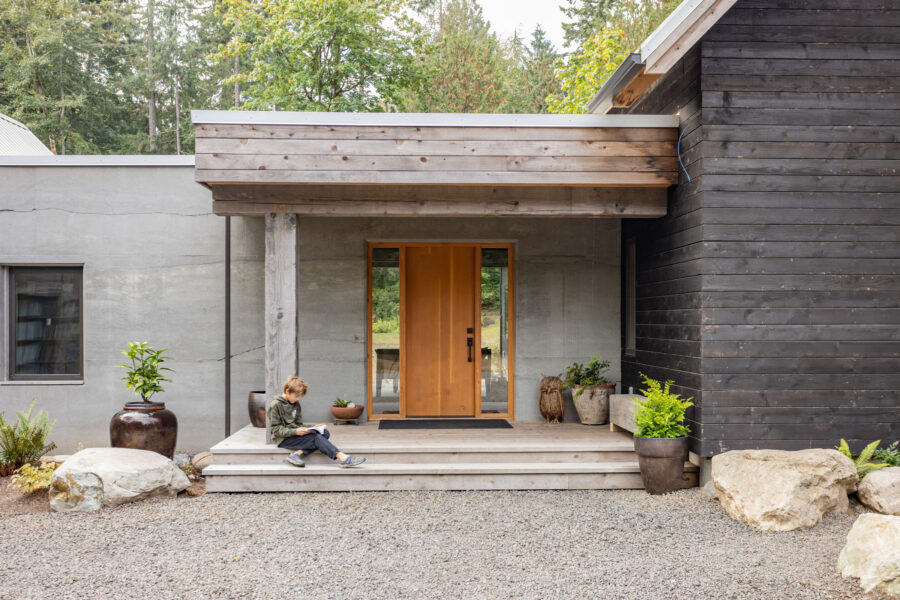
Designed by McLennan Design, the Silver Rock residence on Bainbridge Island makes use of charred shou sugi ban siding. Photo by Emily Hagopian
Originating in Japan, yakisugi—or shou sugi ban, as it’s known in the west—is a type of wood preservation treatment that uses charring to strengthen and improve timber’s resiliency to the elements. Charring causes wood’s most flammable component, cellulose, to burn away, leaving only carbonized charcoal on the surface. This charcoal layer requires extreme heat to burn and acts as a protective barrier, effectively making shou sugi ban siding waterproof, fire-retardant, and pest-resistant—all without the aid of chemical preservatives or coatings.
“That thick layer of char-induced carbon protects the wood from the elements and other things that might degrade it, so you can potentially avoid any sort of oil or other type of toxic coating,” Robbie Davis, owner and CEO of Delta Millworks, told gb&d in a previous interview. Delta Millworks is a building products supplier that specializes in shou sugi ban siding, offering a wide selection of colors, textures, and grain patterns.
Because shou sugi ban sequesters carbon and does not require any chemical treatments, it is considered a highly sustainable siding solution. It was this measure of sustainability that led Jason McLennan—founder of McLennan Design and co-creator of the Living Building Challenge—to choose shou sugi ban siding when designing the Silver Rock Living Building Home. “The outside of the home features charred shou sugi ban cedar siding to ensure longevity without the use of chemicals, paints, and stains,” McLennan previously wrote for gb&d.
Pros of Shou Sugi Ban
- Fire retardant
- Weather, water, and rot resistant
- Low maintenance
Cons of Shou Sugi Ban
- Expensive
- Limited versatility
- Perceived liability
4. Architectural Stone Veneer
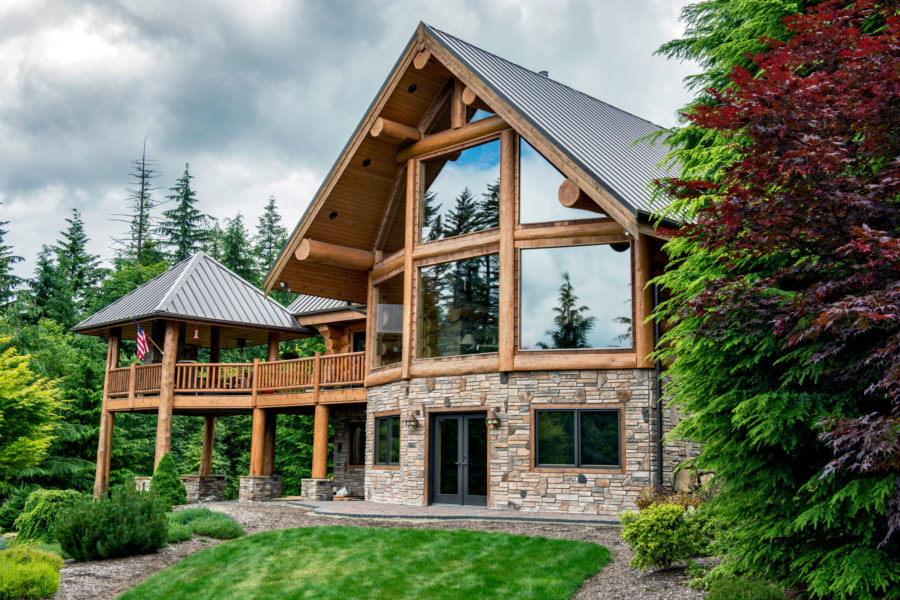
Architectural stone veneer siding installed on a residential cabin. Photo courtesy of Cultured Stone
Architectural stone veneer is a manmade material designed to mimic the look and texture of natural stone at a much lower cost. Depending on the manufacturer, architectural stone veneer may be molded out of foam or a mixture of Portland cement, natural aggregates, and iron oxide pigment. Both are much lighter than natural stone, a quality that allows for greater versatility and which makes for easier installation.
“As a manufactured product, architectural stone veneer opens up a world of almost unlimited product variety, and adding stone elements remains one of the top architectural trends for both exterior and interior applications,” Sarah Lograsso, director of marketing and product design for Cultured Stone, told gb&d in a previous interview.
Cultured Stone is a leading manufacturer of high-quality architectural stone veneer and molds all of their products off of real stone for unparalleled authenticity.
Pros of Architectural Stone Veneer
- Durable and long-lasting
- Lightweight
- Easy to install
Cons of Architectural Stone Veneer
- Susceptible to moisture damage
- May not be sustainable
- Can be expensive
5. Thin Brick Veneer
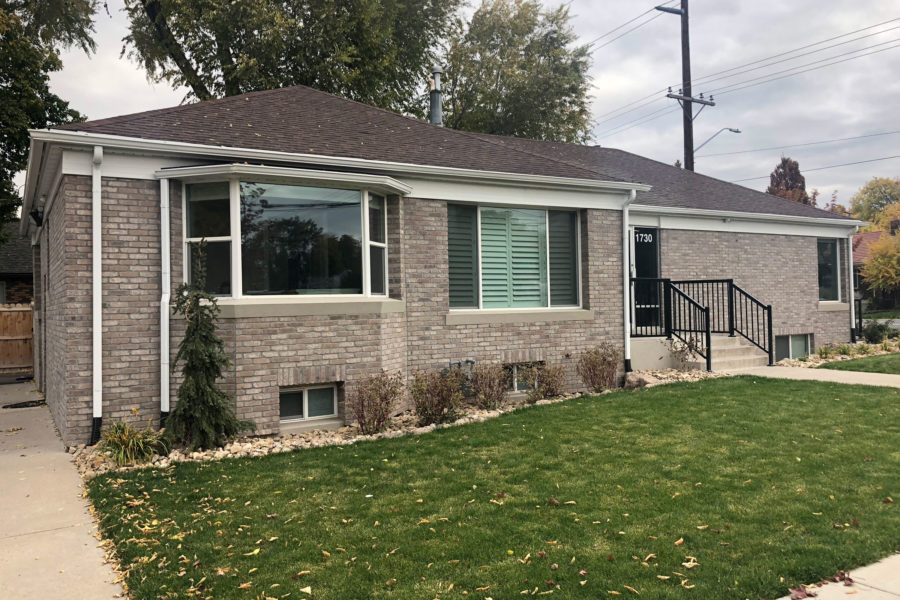
This highly efficient home uses the Old Mill Panel+ System of thin brick veneers. Photo courtesy of Old Mill Brick
Thin brick veneer is an architectural siding product designed to mimic the appearance of brick construction without actually using solid bricks. Instead, thin brick veneer is formed as panels featuring several real brick faces—typically no more than three-quarters-of-an-inch to 1 inch thick—that are then adhered to an existing wall system.
Old Mill Brick is a leading manufacturer of thin brick veneer solutions designed to provide the aesthetic appeal of brick construction at a much lower price. The company offers a range of thin brick veneer styles and patterns, all of which use their patented Brickwebb mesh-mounting system that makes installation quick and easy by eliminating the need for multiple contractors.
“In the old way of doing things, after sheathing a wall up, it would go to a waterproofing contractor to apply the air and water barrier. Then another subcontractor would install the insulation, then finally the mason or exteriors contractor would install the finish,” John Striednig, vice president of commercial operations at Old Mill Brick, told gb&d in a previous article. “With us, everything can go to just one contractor, and that simplifies trade coordination and accelerates the job.”
Pros of Brick Veneer
- Easy installation
- Lightweight
- Energy-efficient
Cons of Brick Veneer
- Susceptible to cracking
- Is not fire- or pest-resistant
- Non-structural
6. Aluminum Siding
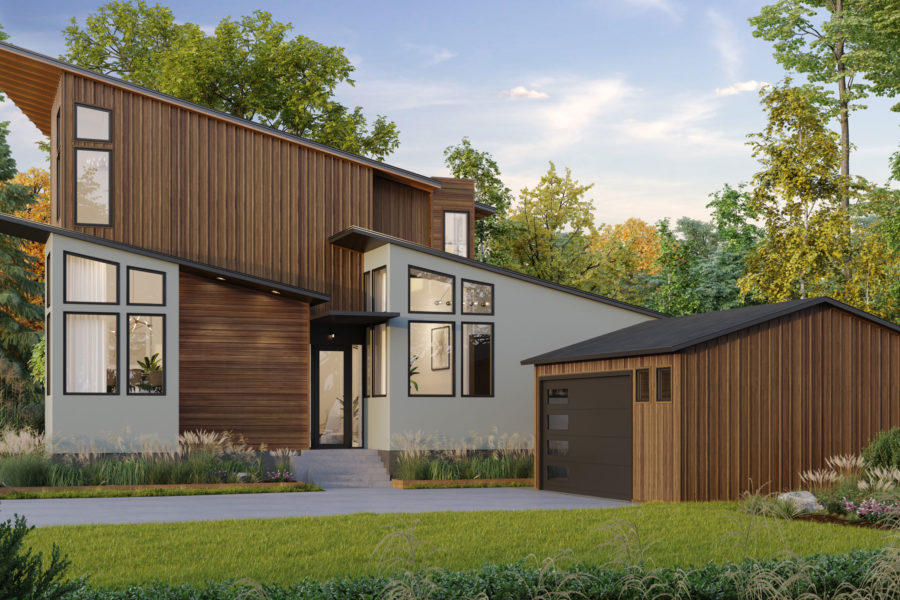
The Cedar Renditions aluminum siding line was developed with a variegated wood-grain design that offers a modern, streamlined look on 6-inch panels. Rendering courtesy of Westlake Royal Building Products
Aluminum siding is a lightweight siding system commonly installed in the lap style, similar to that of vinyl siding. Unlike vinyl, however, aluminum siding is capable of being recycled indefinitely, making it incredibly sustainable. Aluminum siding also isn’t susceptible to cracking in cold weather and is overall a very durable option that is weather-, fire-, and pest-resistant.
Aluminum siding is incredibly easy to maintain and can even be repaired without having to replace an entire section. And while aluminum on its own may not seem particularly appealing, aluminum siding is available in a wide range of colors, patterns, and textures, allowing it to mimic the appearance of other materials.
Westlake Royal Building Products, for example, has developed a line of aluminum siding called Cedar Renditions that features a variegated wood-grain pattern designed to replicate traditional cedar siding. Cedar Renditions allows homeowners to enjoy both the aesthetics of wood siding as well as the low maintenance requirements of aluminum siding.
Pros of Aluminum Siding
- Low-maintenance
- Waterproof
- Recyclable
Cons of Aluminum Siding
- Susceptible to denting and scratching
- Fades over time
- Pinging noises
7. Steel Siding
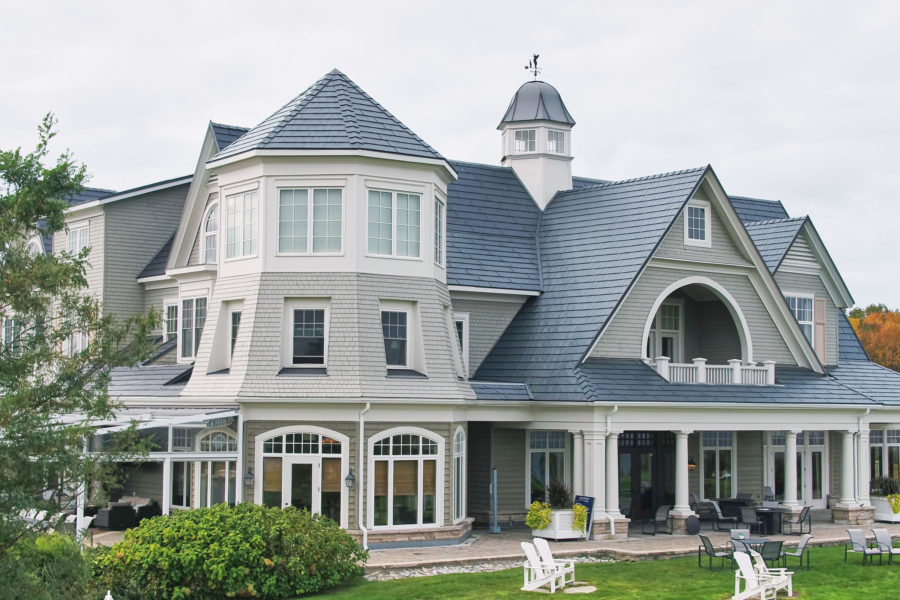
Vicwest’s steel siding and roofing products are durable, long-lasting, and sustainable. Photo courtesy of Vicwest
Aluminum is not, however, the only type of metal siding on the market—there’s also steel siding. Sold as panels in various gauges, steel siding possesses many of the same qualities as aluminum siding (e.g. resistant to insects and rot), but is heavier, stronger, and more durable than aluminum, making it the longer-lasting of the two. Unlike aluminum, however, steel siding is susceptible to rust should it become damaged or after sufficient exposure to the elements, meaning it requires more preventative maintenance.
And while steel manufacturing does account for a significant amount of GHG emissions, steel itself is an infinitely recyclable material that can be reused again and again without losing its quality, ultimately helping to support a circular economy. Many steel siding manufacturers have also begun taking steps to decarbonize their operations; Vicwest, for instance, operates in line with the Kingspan Group’s Planet Passionate program and has implemented emissions reduction strategies throughout their facilities.
Vicwest is a leading manufacturer of metal building envelope solutions, offering a wide variety of steel roofing and siding products. Vicwest’s Bellara line of steel siding, for example, is available in plank, board and batten, and lap form; the Bellara Plank Series is specifically crafted to emulate the look of natural wood while still offering the benefits of steel.
“For our Bellara metal siding, our steel coil painting technology allows us to imprint hyper-realistic wood graphics onto the steel,” Geoff Bernstein, director of marketing at Vicwest, told gb&d in a previous interview. “Even if you’re standing mere inches in front of the product, you can’t tell the difference between the steel siding and natural wood. The resolution of the image we’ve captured makes it indiscernible until you reach out and touch it.”
Pros of Steel Siding
- Infinitely recyclable
- Resistant to fire, insects, and rot
- Durable and long-lasting
Cons of Steel Siding
- Expensive
- Susceptible to dents and scratches
- Rusting concerns
8. Thermally Modified Timber
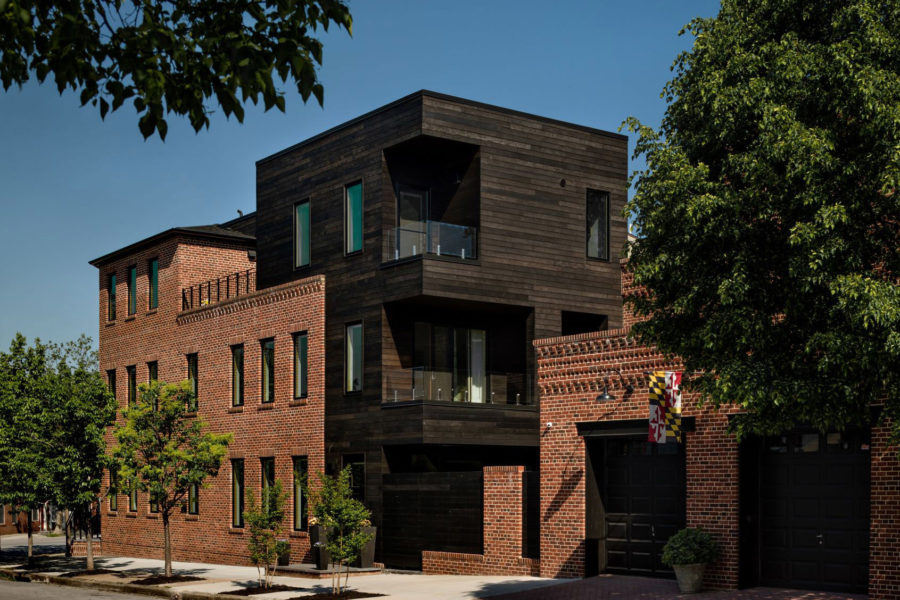
The thermal modification process turns timber a darker, richer color, often making it look like a more exotic hardwood. Photo courtesy of Arbor Wood
Thermally modified timber (TMT) has proven to be a great option in environments that are typically unforgiving to wood, according to Jon Heyesen, the vice president of business development for Intectural, the distributor and producer of Arbor Wood. Through a chemical change using heat and steam, natural wood is made to be more dimensionally stable and less susceptible to humidity and temperature-induced expansion and contraction.
How does heat and steam make wood more stable? Heyesen explained that the breaking up of the hydroxyl groups in the wood’s cellular structure increases both durability and biological resistance by permanently reducing the material’s tendency to absorb water—eliminating the chance of wood serving as a food source for mold, rot, fungal decay, and insects.
Contractors are finding that the improved stability and significant reduction in warping or cupping means better yield and less waste. The material is also lighter in weight, often making it an easier and more predictable material to work with.
Pros of TMT
- Low-maintenance
- Resistant to warping
- Durable and long-lasting
Cons of TMT
- Expensive
- Reduced strength
- Decreased flexibility
9. Vinyl Siding
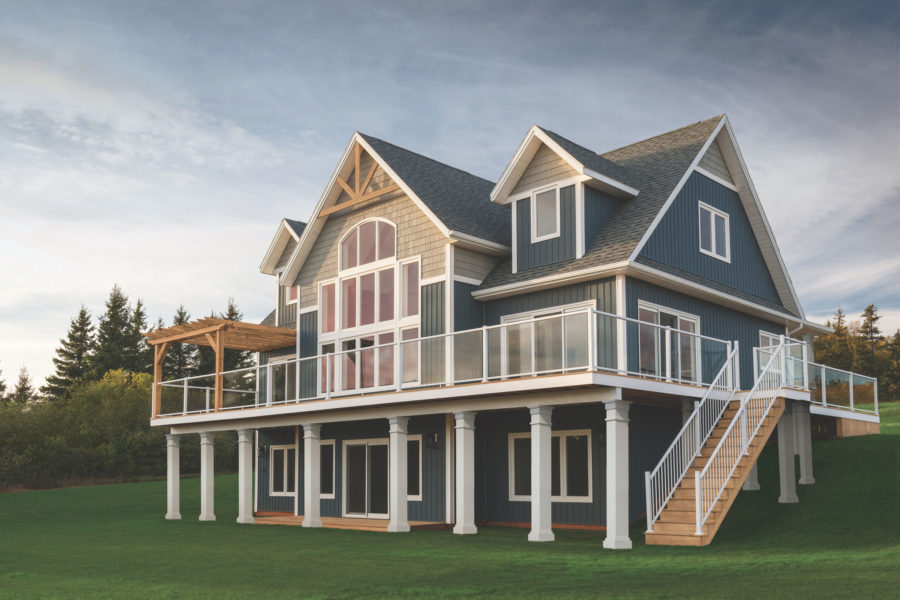
Vinyl siding is one of the most popular types of siding found in the United States. Photo courtesy of Royal Building Products
Although plastic products are not typically considered sustainable, polyvinyl chloride (PVC) challenges that idea. PVC is not only a cost-effective substitute for wood, it is also weatherable, chemically stable, and lightweight. Companies like Royal Building Products use PVC as a material for vinyl siding. PVC resin begins with two abundant building blocks: chlorine from common salt and ethylene from natural gas.
In terms of total environmental impact, vinyl siding outperforms fiber cement and brick, according to Royal Building Products Vice President of Marketing Steve Booz. Compared to vinyl siding, fiber cement contributes almost four times the global warming potential; more than two times the acidification; and more than three-and-a-half times the air pollution.
Vinyl also does not require painting or staining and needs only occasional cleaning, unlike other exterior materials like brick and fiber cement.
Pros of Vinyl Siding
- Low maintenance
- Inexpensive
- Range of design options
Cons of Vinyl Siding
- Susceptible to cracking in cold weather
- May fade over time
- Can’t be repainted
10. Clay Tile
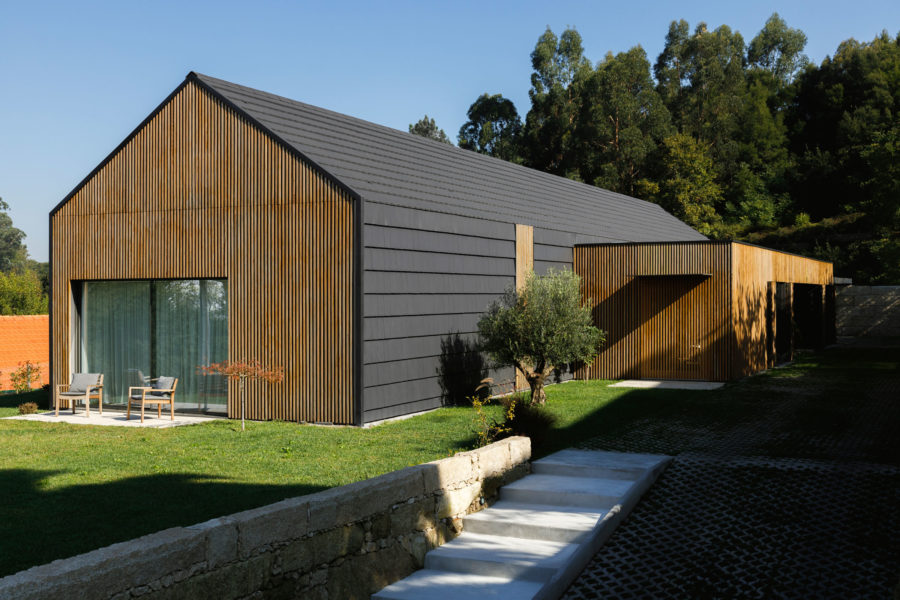
The Santo Tirso House’s industrial black tiles contrast against the honey tone of thermally modified wood. Photo by Ivo Tavares Studio
While it is more common to see terra-cotta used as a cladding system on large commercial buildings, clay tile has grown increasingly popular as a type of residential siding, both for its sleek appearance and high durability. The high temperatures clay tile is subjected to as part of the firing process are what gives the material its strength, allowing it to withstand high winds, weather, and fire without significant damage.
Clay tile can also offer a striking contrast when paired with other siding materials. The HOUS3 architecture firm, for example, fused the properties of black terra-cotta tile and thermally modified wood to create an eccentric connection when designing the Santo Tirso House in Portugal. “The relationship is extreme between hardwood and industrial tile, but it works as a whole. Industrial black enhances the honey tone and natural gray oxidation of the wood,” Fábio Costa, architect and founder of HOUS3, told gb&d in a previous interview.
The design team utilized CS – Coelho da Silva’s—a Portuguese ceramic manufacturer—Plasma line of tiles for the home’s roof and exterior volumes. Although designed primarily for use as roofing tiles, the Plasma line boasts a range of fittings and features a unique interlocking system that allows the tiles to be used for siding purposes as well. When used in this manner, the tiles create “a skin that allows a separation between the exterior and the interior of the house, that is, it creates a ventilated facade,” according to Costa.
Pros of Clay Tile
- Aesthetically pleasing
- Durable and weather-proof
- Low-maintenance
Cons of Clay Tile
- Heavy
- Expensive
- Can be difficult to install
11. Cellular Composite PVC

Westlake Royal’s Celect brand of cellular composite siding features interlocking joints. Photo courtesy of Westlake Royal Building Products
Cellular composite PVC siding is a relatively new material that combines the best qualities of cellular PVC—a type of polyvinyl chloride that boasts improved flexibility over traditional vinyl siding—and wood composite siding for unparalleled beauty, durability, and weather-resistance.
Westlake Royal Building Products is the primary manufacturer of cellular composite PVC siding, exemplified by their Celect® product line. Celect is incredibly weather-resistant, will not peel, crack, or chip, and features a slick surface that prevents dirt and mildew build-up, making for easy cleaning.
Celect also features a Kynar Aquatic® color coating that helps reflect solar energy and prevent UV damage, improving a home’s overall energy efficiency and eliminating the need for repainting. Celect is available in 5-inch and 7-inch smooth lap siding as well as shake, clapboard, and board and batten.
Pros of Cellular Composite PVC
- Recyclable
- Weather- and pest-resistant
- Durable and strong
Cons of Cellular Composite PVC
- Can be expensive
- Installation requires expertise and may be time consuming
12. Hardwood
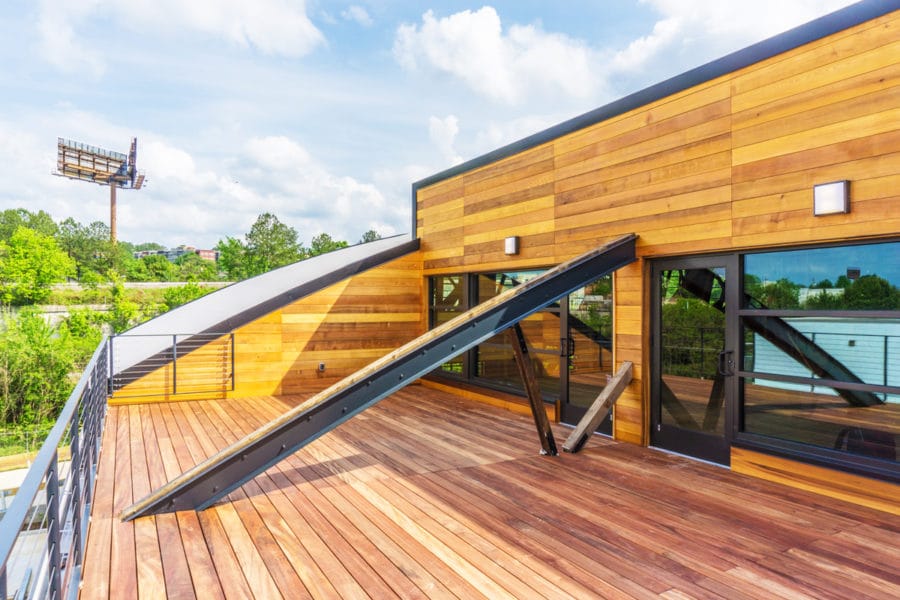
Tigerwood, a reddish wood with darker stripes, is commonly used as an accent on modern homes. Photo courtesy of OHC
Overseas Hardwoods Company (OHC) produces multiple types of hardwood, depending on design, budget, and climate. Two of their products—Tigerwood and Garapa—both compliment a modern look with their golden hues.
Exactly how it sounds, when oiled, tigerwood takes on a reddish hue with darker stripes—mimicking the look of a tiger’s fur. Tigerwood is very durable with a life of 25-plus years. Because of its unique look, tigerwood is commonly used as an accent on modern homes. “It looks beautiful next to the clean modern lines of a concrete home,” Ben Roberts, marketing director of OHC, previously said to gb&d. “It is very striking.”
The lightest of hardwoods is Garapa, which has a golden brown color similar to beige. As with all hardwoods, garapa has no large knots. “It’s great for modern applications,” Roberts told gb&d. “It complements clean lines with a lighter color.” Even if left to gray, garapa continues to maintain an even color.
Pros of Hardwood
- Aesthetically pleasing
- Improves resale value
- Natural insulator
Cons of Hardwood
- May not be harvested sustainably
- Susceptible to moisture damage
- Expensive
13. Pre-Finished Siding

This property uses Diamond Kote’s pre-finished Terra Bronze RigidStack siding, sand board, and batten with white nail fin trim and nail fin outside corners. Photo courtesy of Diamond Kote Building Products
Pre-finished sidings are coated in a factory-controlled environment before installation. This process can speed up the labor-intensive process of staining the materials on site, and it allows for immense customization.
With Diamond Kote Building Products, clients can choose a contemporary, traditional, or rustic look. Diamond Kote offers options that include 23 solid colors and six duo-blends, with the ability to do custom colors. The pre-finishing process helps ensure consistent color and finish application, making for a more uniform end product.
“One of the important factors of being a pre-finisher is that everything is designed to be color matched to our color palette, which makes it easy for the ordering process,” Andy Stray, brand development manager for Diamond Kote, previously told gb&d. “And it also provides excellent aesthetics when the project is complete.” All of Diamond Kote’s siding comes with a 30-year no-fade warranty.
Pros of Pre-Finished Siding
- Highly customizable
- Shorter on-site construction times
- Consistent and durable finish
Cons of Pre-Finished Siding
- Higher upfront costs
- Potential for damage during transit
14. Thin Fiber Cement Siding
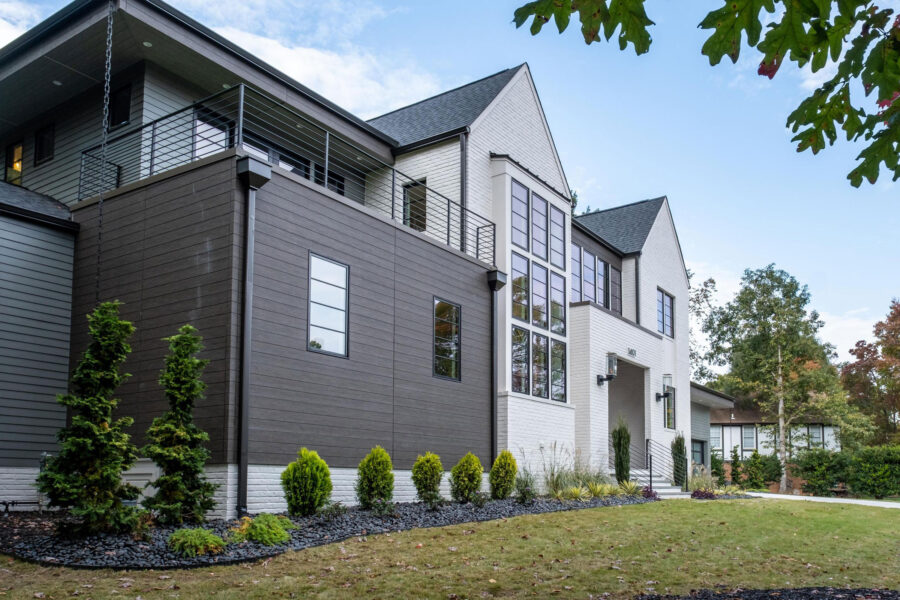
Nichiha’s popular VintageWood line of thin fiber cement siding. Photo courtesy of Nichiha
It has been said that cement products all look the same, but it doesn’t have to be that way. Companies like Nichiha create cement composites that can be made in many textures and finishes, ranging from reclaimed wood or limestone to brick and mortarless stone.
Fiber cement is also durable and inexpensive compared to other siding options like hardwood and modified wood, according to Tim Seims, market segment manager at Nichiha.
Fiber cement siding is resistant to warping, termites, rot, impact, and fire. As far as durability in extreme elements, almost every fiber cement manufacturer has Miami-Dade hurricane testing approval in Florida, Seims previously told gb&d.
Seims explained that Nichiha’s manufacturing process uses a mixture of cement, sand, wood fibers, and fly ash, a post-industrial waste product that would otherwise end up in landfills. Their products can also be reused, and the longevity of fiber cement helps improve a building’s sustainability, too.
Pros of Thin Fiber Cement
- Low maintenance
- Durable and long-lasting
- Fire, insect, and rot resistant
Cons of Thin Fiber Cement
- Can be difficult to install
- Relatively low insulation value
- Expensive
15. Bamboo
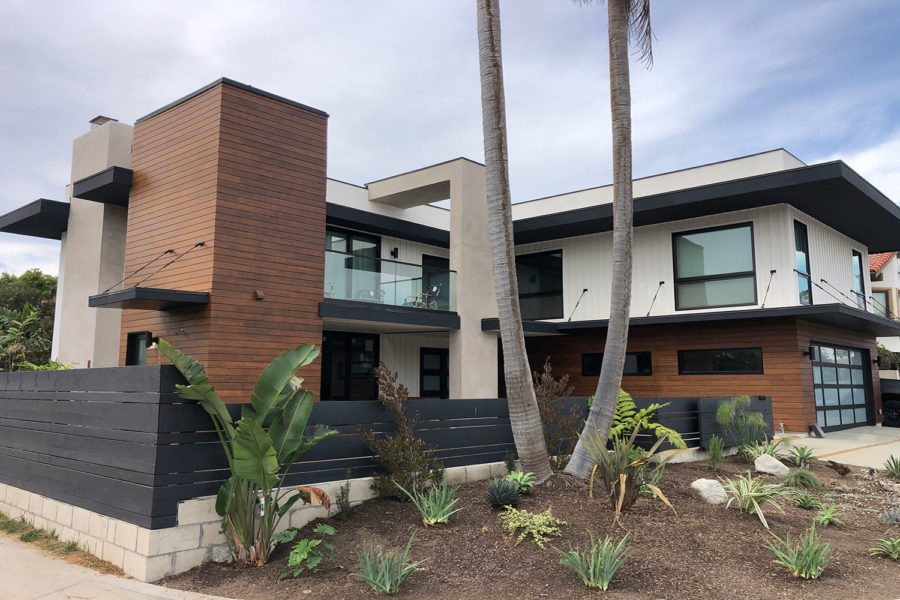
Bamboo siding offers the appearance of wood but is much more sustainable. Photo courtesy of dasso USA
Fused bamboo is another excellent choice for siding, according to Bamboo Ambassador Avery Chua, as it combines wood’s aesthetic appeal with plastic composite’s durability to make for a perfect outdoor material.
What is fused bamboo? It is bamboo harvested at peak growth, shredded into strands, and then extracted of nutrients. Those bamboo strands—no longer containing nutrients—are then recombined (fused) into a dense, durable panel.
The dasso Group’s bamboo material has the look and feel of natural wood, minus the downsides—a short life span, fungus growth, prone to insect and termite attack, rotting, and instability. Similar to plastic composite, it is low maintenance, durable, and non-rotting in nature.
Pros of Bamboo
- High stability
- Long lifespan
- Moisture, rot, and pest resistant
Cons of Bamboo
- Expensive
- Limited design options
- Often requires overseas shipping
Samantha Stevens contributed to this article.

